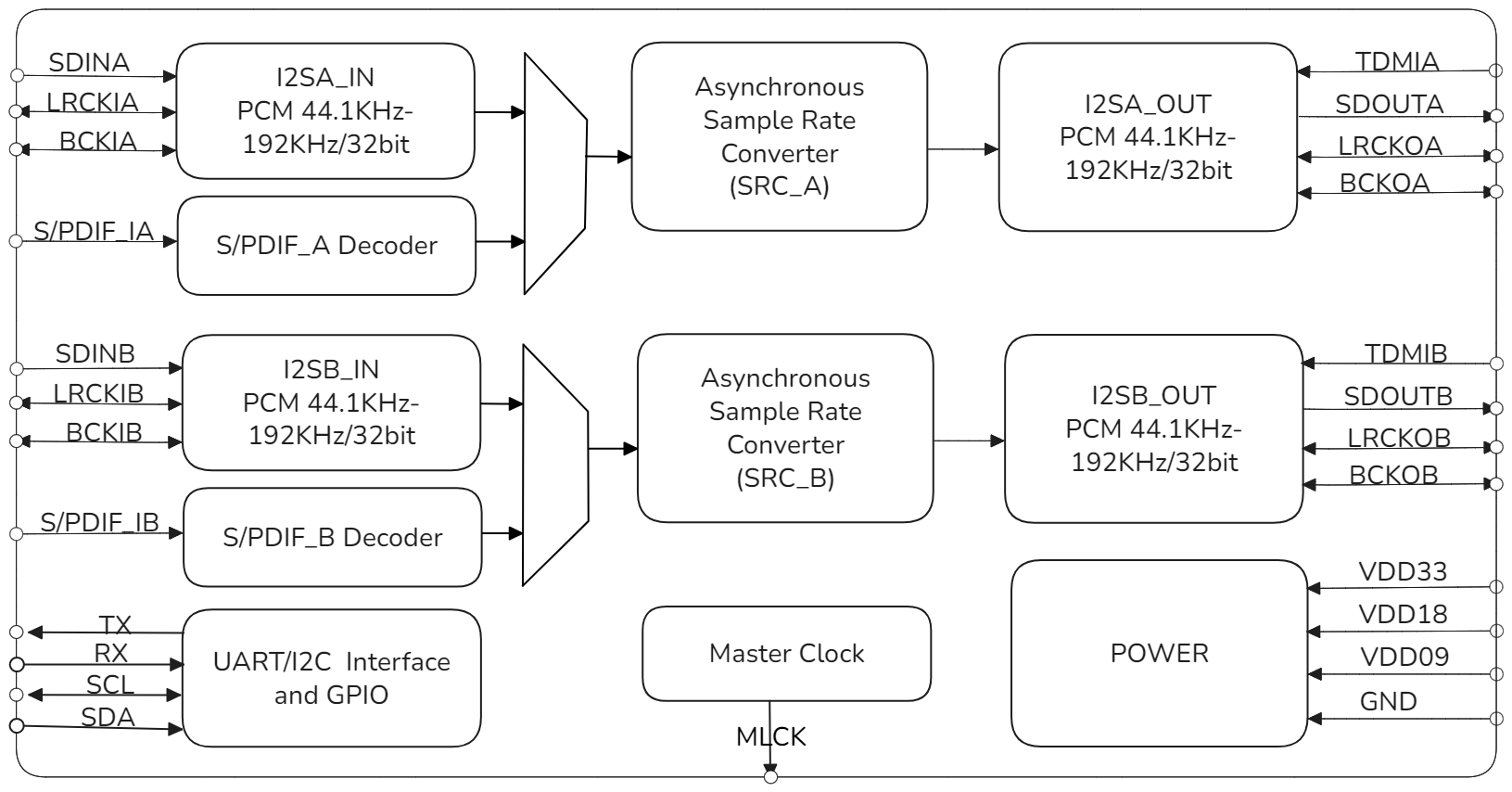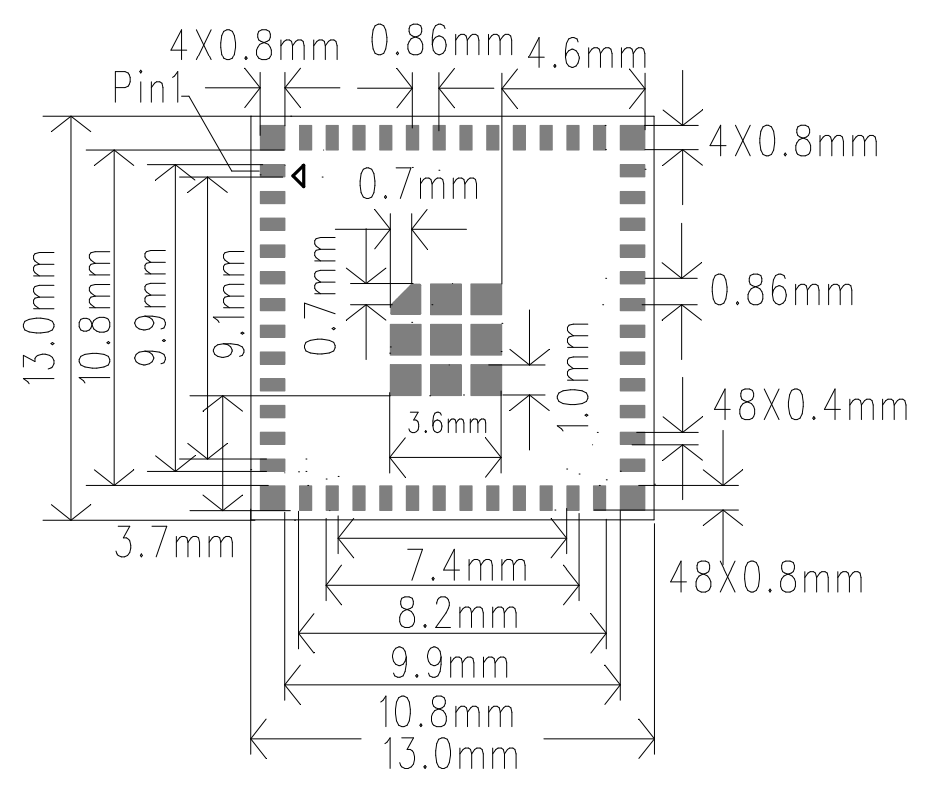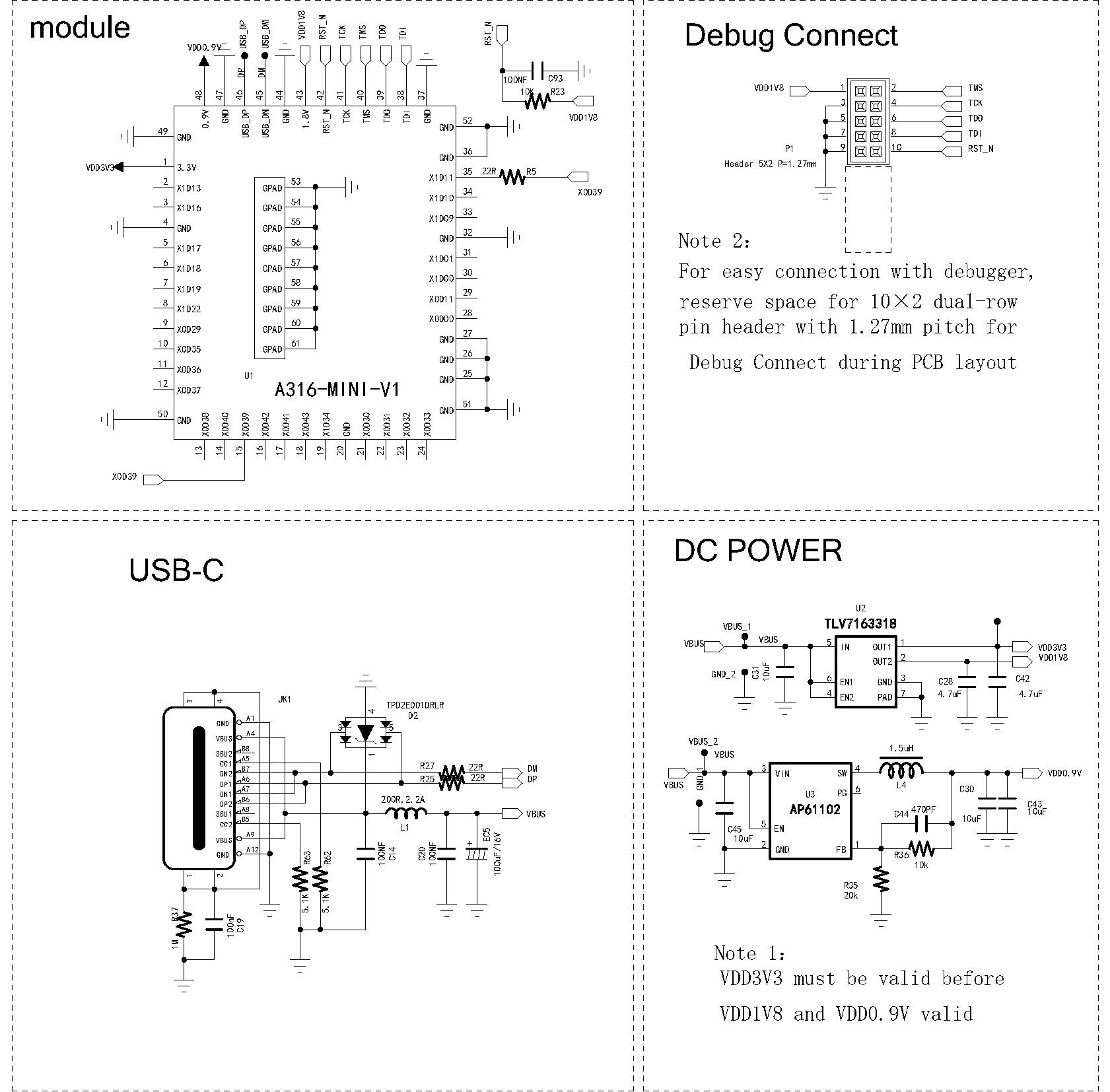XMSRC4194-VC1¶
4-Channel 192KHz ASRC Audio Sample Rate Converter with 2x S/PDIF and 2x I2S Interfaces and TDM Cascade Mode
1. Introduction¶
1.1 Product Description¶
XMSRC4194 is a high-performance 4-channel asynchronous sample rate converter based on XMOS chip architecture. The product is fully compatible with the core functional specifications of SRC4194, including 16:1 to 1:16 wide-range sample rate conversion, 144dB dynamic range, and comprehensive support for various digital audio formats such as I2S, Left-justified, Right-justified, and TDM.
- Compared to SRC4194, the core advantage of XMSRC4194 is the integration of two additional S/PDIF input interfaces, providing users with more flexible signal source selection. Users can flexibly switch between I2S input and S/PDIF input according to application requirements, significantly enhancing system connectivity and adaptability.
- The XMOS chip architecture ensures high reliability and excellent audio processing performance, providing professional audio equipment manufacturers with a more competitive solution.
- Dual SRC module architecture, with each module processing 2 audio channels, can operate independently, enabling simultaneous processing of 4-channel audio sample rate conversion.
1.2 Product Features¶
-
Four-Channel SRC Audio Sample Rate Conversion
- Dual SRC Module Architecture (SRC_A + SRC_B)
- Each module processes 2 audio signals
- Independently configurable input sources
- Total capability to simultaneously process 4-channel audio sample rate conversion
- Flexible Signal Routing
- SRC_A options: I2S_A_IN or S/PDIF_A (select one)
- SRC_B options: I2S_B_IN or S/PDIF_B (select one)
- Supports multiple operating mode combinations
- Dual SRC Module Architecture (SRC_A + SRC_B)
-
Ultra-High Sample Rate Conversion Support
- ASRC (Asynchronous Sample Rate Conversion)
- Supports sample rate conversion between 44.1KHz-192KHz
- Supports 16:1 to 1:16 wide-range input-output sample rate ratios
- Automatic input-output sample rate detection
- Audio Data Processing
- Supports 16bit/24bit/32bit audio data processing
- 144dB dynamic range
- THD+N: -140dB
- ASRC (Asynchronous Sample Rate Conversion)
-
Multi-Interface Support
- S/PDIF Interface
- 2 S/PDIF input interfaces (S/PDIF_A, S/PDIF_B)
- Each SRC module can independently select S/PDIF input
- Compatible with AES3, IEC 60958, and EIAJ CP-1201 standards
- I²S Interface
- 4 I²S interfaces (2 inputs + 2 outputs)
- Supports Master/Slave mode (independently configurable)
- S/PDIF Interface
-
Comprehensive Digital Audio Format Support
- Supports I2S, Left-Justified, Right-Justified formats
- Complete TDM time-division multiplexing format support, cascadable up to 4 devices
- Supports 16bit/24bit/32bit audio data processing
- All output data dithered from internal 28-bit data path
-
Flexible Configuration Interface
- I²C/UART Configuration Interface
- Supports both I²C and UART dual-protocol configuration
- Configurable Parameters
- SRC_A and SRC_B input source selection (I²S or S/PDIF)
- I²S sample rate configuration (Master mode)
- Master/Slave mode switching
- I²S audio format (I²S/Left-Justified/Right-Justified)
- TDM mode configuration
- I²C/UART Configuration Interface
-
Intelligent Clock Management
- Master Clock Output (MCLK)
- Supports 128fs, 256fs, 512fs, 1024fs reference clock
- Clock Domain Constraints
- One port in Master mode, the other port in Slave mode
- Or both ports in Slave mode
- Master mode port requires valid RCKI reference clock
- Master Clock Output (MCLK)
1.3 Application Scenarios¶
-
Professional Recording Studios
- High-precision sample rate conversion in multi-track recording equipment
- Processing audio materials with different sample rates in audio workstations
- Achieving audio signal format unification in mixer systems
-
Broadcasting and Television
- Real-time audio signal processing in broadcast equipment
- Synchronized processing of audio from different sources in television production
- Optimized audio signal conversion in live streaming systems
-
Digital Audio Systems
- Audio signal preprocessing in amplifier equipment
- Multi-channel signal conversion in audio processors
- Signal optimization in speaker management systems
-
Automotive Audio
- Audio format conversion in in-car entertainment systems
- Audio quality optimization processing in high-end audio systems
- Signal processing in noise reduction systems
-
Consumer Electronics
- Audio signal processing in high-end audio equipment
- Multi-channel processing in home theater systems
- Signal conversion in professional audio interfaces
-
Industrial Applications
- Signal standardization in audio test equipment
- Data processing in audio analysis instruments
- Format conversion in professional signal processing equipment
1.4 Product Block Diagram¶

1.5 Ordering Information¶
| PRODUCT MODEL | ORDERING NUMBER | PACKAGE BODY | SIZE (NOM) | Hardware Model | Comments |
|---|---|---|---|---|---|
| XMSRC4194-VC1 | XMSRC4194-VC1 | SMT LGA-52 | 13x13mm | A316-Mini-V1 | 4-channel 192KHz ASRC sample rate converter, dual SRC modules, 2x S/PDIF inputs, TDM cascade |
2. Modes and Specifications¶
2.1 Supported Input-Output Modes¶
XMSRC4194-VC1 employs a flexible modular design where two SRC modules (SRC_A and SRC_B) can be independently configured for input sources. The following lists typical application modes:
| Mode Number | SRC_A Configuration | SRC_B Configuration | Description |
|---|---|---|---|
| 1 | S/PDIF_A → SRC_A → I²S_A_OUT (Master) | S/PDIF_B → SRC_B → I²S_B_OUT (Master) | Dual S/PDIF to I²S output |
| 2 | I²S_A_IN (Slave) → SRC_A → I²S_A_OUT (Master) | I²S_B_IN (Slave) → SRC_B → I²S_B_OUT (Master) | Independent dual-channel sample rate conversion |
| 3 | I²S_A_IN (Slave) → SRC_A → TDM_OUT | I²S_B_IN (Slave) → SRC_B → TDM_OUT | TDM cascade output mode |
| 4 | S/PDIF_A → SRC_A → TDM_OUT | S/PDIF_B → SRC_B → TDM_OUT | S/PDIF to TDM cascade output |
Mode Configuration Notes
- SRC_A optional input sources: I²S_A_IN or S/PDIF_A (select one)
- SRC_B optional input sources: I²S_B_IN or S/PDIF_B (select one)
- TDM mode supports cascading up to 4 devices
- Configuration dynamically switchable via I²C/UART interface
2.2 Detailed Parameters for Each Operating Mode¶
2.2.1 Mode 1: Dual S/PDIF Input → Dual I²S Output¶
Application Scenario: S/PDIF signal conversion to dual I²S output, suitable for digital audio systems
Signal Flow:
Parameter Configuration:
| Parameter | SRC_A | SRC_B |
|---|---|---|
| Input Source | S/PDIF_A | S/PDIF_B |
| Input Format | S/PDIF | S/PDIF |
| Output Interface | I²S_A (Master) | I²S_B (Slave) |
| Sample Rate | 44.1KHz~192KHz (ASRC) | 44.1KHz~192KHz (ASRC) |
| Bit Depth | 16/24/32bit | 16/24/32bit |
2.2.2 Mode 2: Dual I²S Input → Dual I²S Output¶
Application Scenario: Independent dual-channel sample rate conversion, suitable for multi-track recording equipment
Signal Flow:
Parameter Configuration:
| Parameter | SRC_A | SRC_B |
|---|---|---|
| Input Source | I²S_A_IN (Slave) | I²S_B_IN (Slave) |
| Output Interface | I²S_A (Master) | I²S_B (Slave) |
| Sample Rate | 44.1KHz~192KHz (ASRC) | 44.1KHz~192KHz (ASRC) |
| Bit Depth | 16/24/32bit | 16/24/32bit |
2.2.3 TDM Cascade Mode (Mode ¾)¶
Application Scenario: Multi-device cascading, suitable for professional multi-channel audio systems
TDM Frame Format: - Frame rate = output sample frequency (fs) - Bit clock frequency (BCKO) = N × 64fs (N = number of cascaded devices) - Each subframe = 64 bits (left channel 32 bits + right channel 32 bits) - Audio data left-aligned, MSB first
Cascade Capability:
Typical Configuration Examples:
| Output Sample Rate | BCKO Frequency | Maximum Cascade |
|---|---|---|
| 48kHz | 12.288MHz | 4 devices |
| 96kHz | 24.576MHz | 4 devices |
| 192kHz | 24.576MHz | 2 devices |
2.3 Audio Performance Specifications¶
| Performance Metric | ASRC Mode | Test Conditions |
|---|---|---|
| Resolution | 16-32 bit | - |
| Input Sample Frequency | 44.1kHz ~ 192kHz | - |
| Output Sample Frequency | 44.1kHz ~ 192kHz | - |
| Dynamic Range | 144dB | -60dBFS input, A-weighted |
| THD+N | -140dB | 0dBFS input, 20Hz~fs/2 |
2.4 Feature Comparison¶
| Feature | XMSRC4194 | SRC4194 | Advantage |
|---|---|---|---|
| SRC Channels | 4 channels | 4 channels | Same processing capability |
| SRC Modules | 2 independent modules | 2 modules | 2x processing capability |
| S/PDIF Input | 2 channels | Not supported | More input interfaces |
| Maximum Sample Rate (ASRC) | 192 KHz | 216 KHz | Comparable performance |
| External Clock Reference | No external clock required | Requires external clock | Saves external crystal cost |
| Scalability | Expandable | Not expandable | More flexible |
| TDM Cascade | Supports 4 devices | Supports 4 devices | Same cascade capability |
3. Pin Configuration and Functions¶
3.1 XMSRC4194_VC1 Pin Layout¶

3.2 XMSRC4194_VC1 Pin Description¶
| Pin Number | Name | Type | Function |
|---|---|---|---|
| 1 | 3.3V | P | Module 3.3V power supply |
| 2 | X1D13 | I | S/PDIF_IB (S/PDIF input B) |
| 3 | X1D16 | I/O | LRCKOB (I²S_B output frame sync, Master output/Slave input) |
| 4 | GND | P | Module ground |
| 5 | X1D17 | I/O | BCKOB (I²S_B output bit clock, Master output/Slave input) |
| 6 | X1D18 | - | Reserved |
| 7 | X1D19 | - | Reserved |
| 8 | X1D22 | - | Reserved |
| 9 | X0D29 | I/O | UART_RX/I2C_SDA (UART receive/I2C data) |
| 10 | X0D35 | I/O | BCKIA (I²S_A input bit clock, Master output/Slave input) |
| 11 | X0D36 | I/O | LRCKIA (I²S_A input frame sync, Master output/Slave input) |
| 12 | X0D37 | I | SDINA (I²S_A data input) |
| 13 | X0D38 | I | TDMIA (TDM data input A, TDM mode only) |
| 14 | X0D40 | I/O | LRCKOA (I²S_A output frame sync, Master output/Slave input) |
| 15 | X0D39 | O | MCLK_OUT (Master clock output) |
| 16 | X0D42 | - | Reserved |
| 17 | X0D41 | I/O | BCKOA (I²S_A output bit clock, Master output/Slave input) |
| 18 | X0D43 | - | Reserved |
| 19 | X1D34 | I | SDINB (I²S_B data input) |
| 20 | GND | P | Module ground |
| 21 | X0D30 | I/O | I2C_SCL (I2C clock) |
| 22 | X0D31 | I/O | UART_I2C_SEL (UART/I2C selection) |
| 23 | X0D32 | I/O | UART_TX (UART transmit) |
| 24 | X0D33 | - | Reserved |
| 25 | GND | P | Module ground |
| 26 | GND | P | Module ground |
| 27 | GND | P | Module ground |
| 28 | X0D00 | I | S/PDIF_IA (S/PDIF input A) |
| 29 | X0D11 | O | SDOUTA (I²S_A data output) |
| 30 | X1D00 | I/O | LRCKIB (I²S_B input frame sync, Master output/Slave input) |
| 31 | X1D01 | I | TDMIB (TDM data input B, TDM mode only) |
| 32 | GND | P | Module ground |
| 33 | X1D09 | O | SDOUTB (I²S_B data output) |
| 34 | X1D10 | I/O | BCKIB (I²S_B input bit clock, Master output/Slave input) |
| 35 | X1D11 | O | MCLK_OUT (Master clock output) |
| 36 | GND | P | Module ground |
| 37 | GND | P | Module ground |
| 38 | TDI | I/O | JTAG debug interface |
| 39 | TDO | I/O | JTAG debug interface |
| 40 | TMS | I/O | JTAG debug interface |
| 41 | TCK | I/O | JTAG debug interface |
| 42 | RST_N | I | System reset, active low |
| 43 | 1.8V | P | Module 1.8V power supply |
| 44 | GND | P | Module ground |
| 45 | USB_DM | I/O | USB_DM (Reserved, not used) |
| 46 | USB_DP | I/O | USB_DP (Reserved, not used) |
| 47 | GND | P | Module ground |
| 48 | 0.9V | P | Module 0.9V power supply |
| 49 | GND | P | Module ground |
| 50 | GND | P | Module ground |
| 51 | GND | P | Module ground |
| 52 | GND | P | Module ground |
Pin Type Definition
I/O types in the table: I=Input, O=Output, P=Power, I/O=Input/Output
Important Notes
- S/PDIF Inputs: Each SRC module corresponds to one S/PDIF input
- Pin 28(X0D00): S/PDIF_IA (corresponds to SRC_A)
- Pin 2(X1D13): S/PDIF_IB (corresponds to SRC_B)
- I²S_A Interface:
- Input: BCKIA(X0D35), LRCKIA(X0D36), SDINA(X0D37), TDMIA(X0D38)
- Output: BCKOA(X0D41), LRCKOA(X0D40), SDOUTA(X0D11)
- I²S_B Interface:
- Input: BCKIB(X1D10), LRCKIB(X1D00), SDINB(X1D34), TDMIB(X1D01)
- Output: BCKOB(X1D17), LRCKOB(X1D16), SDOUTB(X1D09)
- UART/I2C Interface Selection: Interface type selected via pin 22(X0D31) UART_I2C_SEL signal
- UART mode: Pin 9(X0D29)=UART_RX, Pin 23(X0D32)=UART_TX
- I2C mode: Pin 9(X0D29)=I2C_SDA, Pin 21(X0D30)=I2C_SCL
- MCLK Output: Pin 15(X0D39) and Pin 35(X1D11)
- Required for Master mode, supports 128fs/256fs/512fs/1024fs
- TDM Input: TDMIA(X0D38) and TDMIB(X1D01) used only in TDM mode for cascading
- Clock Constraints: All Master I2S ports must be in the same clock domain, i.e., either all in 44.1KHz clock domain or all in 48KHz clock domain
4. Configuration Interface Description¶
4.1 I²C/UART Configuration Interface¶
XMSRC4194-VC1 supports both I²C and UART dual-protocol configuration, providing flexible configuration methods. The UART_I2C_SEL signal on pin 22(X0D31) can be used to select which configuration interface to use:
| Configuration Method | Pin 22(X0D31) | Communication Interface | Description |
|---|---|---|---|
| Pull-up | UART_I2C_SEL | UART mode | Pin 9(X0D29)=UART_RX, Pin 23(X0D32)=UART_TX |
| Pull-down | UART_I2C_SEL | I²C mode | Pin 9(X0D29)=I2C_SDA, Pin 21(X0D30)=I2C_SCL |
4.2 Configurable Parameters¶
The following parameters can be configured via I²C or UART interface:
| Parameter Type | Configuration Options | Description |
|---|---|---|
| SRC_A Input Source | I²S_A_IN / S/PDIF_A | Select input source for SRC_A module (select one) |
| SRC_B Input Source | I²S_B_IN / S/PDIF_B | Select input source for SRC_B module (select one) |
| I²S_A Mode | Master / Slave | I²S_A operating mode |
| I²S_B Mode | Master / Slave | I²S_B operating mode |
| I²S_A Sample Rate | 4kHz~192kHz | |
| I²S_B Sample Rate | 4kHz~192kHz | |
| I²S_A Input Format | I²S/Left-Justified/Right-Justified | Audio data format |
| I²S_B Input Format | I²S/Left-Justified/Right-Justified | Audio data format |
| I²S_A Output Format | I²S/Left-Justified/Right-Justified/TDM | Audio data format |
| I²S_B Output Format | I²S/Left-Justified/Right-Justified/TDM | Audio data format |
| Output Word Length | 16/24/32 bits |
Configuration Notes
- Master mode constraint: All Master I2S ports must be in the same clock domain, i.e., either all in 44.1KHz clock domain or all in 48KHz clock domain
- For detailed configuration commands, please refer to the configuration protocol documentation
4.3 MCLK Configuration¶
- Master mode ports require MCLK for generating LRCK and BCK:
- MCLK supports 128fs/256fs/512fs/1024fs
5. Hardware Parameters¶
5.1 Normal Operating Conditions¶
| Function | Minimum | Typical | Maximum | Unit |
|---|---|---|---|---|
| Operating Temperature | 0 | - | 70 | ℃ |
| 3.3V Operating Voltage | 3.0 | 3.3 | 3.6 | V |
| 1.8V Operating Voltage | 1.62 | 1.80 | 1.98 | V |
| 0.9V Operating Voltage | 0.855 | 0.90 | 0.945 | V |
5.2 Product Dimensions¶
13±0.1mm(L)X13±0.1mm(W)X0.8±0.1mm(H)
5.3 Module Package Diagram¶

6. Minimum System Reference Design¶

7. Product Packaging Information¶
Tray + Outer Box Packaging
8. Revision History¶
| Version | Date | Description | Revised By |
|---|---|---|---|
| V1.0 | 2025-10-6 | Initial release | Technical Documentation Department |

